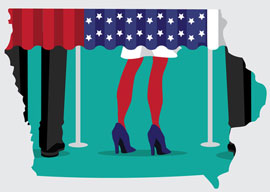
February 02, 2016

Source: Shutterstock
Whoever wins the nominations, the most successful campaigns of 2016 provide us with a clear picture of where the center of gravity is today in both parties and, hence, where America is going.
Bernie Sanders, with his mammoth crowds and mass support among the young, represents, as did George McGovern in 1972, despite his defeat, the future of the Democratic Party.
That Hillary Clinton has been tacking left tells you Sanders is winning the argument. Should she avoid indictment in the email scandal, and win the nomination and the election, Clinton would be a placeholder president.
Yet, should Sanders win the nomination and election—highly improbable—he would become a frustrated and a failed president.
Why? Consider what he has on offer.
Free college tuition and universal health care, a breakup of the big banks and a reform of the tax code to make the Fortune 500 and the millionaires and billionaires pay for it all. Soak the rich!
Sound socialist economics, but this is the formula that turned Puerto Rico and Illinois into the booming showcases they are today. Moreover, unless Sanders swept both houses of Congress and won a 67-vote, veto-proof majority in the Senate, his agenda would be dead on arrival on Capitol Hill.
Yet there are areas where the Sanders agenda overlaps that of Donald Trump and other Republican candidates. Bernie is an anti-interventionist, anti-nation-building, anti-empire leftist of a breed common in the Labor Party after World War II, when the British Empire was liquidated, Churchill notwithstanding.
Moreover, Sanders is no free-trade globalist of the Davos school. He opposed NAFTA, GATT and MFN for China. Like Trump, he backs a trade policy that puts American workers first.
Thus, on both trade and foreign policy, there is common ground between the rebellions in the Democratic and Republican parties, even as Clinton has ideological allies among the GOP free-traders and neocons of the Bush I and II presidencies.
But while difficult to see how Sanders captures the nomination and wins in November, the rebellion in the GOP is larger, stronger and deeper. In every national or state poll, anti-establishment candidates command a majority of Republican voters. Which presents a problem for the establishment.
The Beltway elites may succeed in blocking Trump or Ted Cruz. But the eventual nominee and the party will have to respect and to some degree accommodate the agendas of the rebellion on immigration, border security, trade and anti-intervention, or face a fatal split.
We have been here before.
After Richard Nixon lost to JFK in 1960, the Goldwater movement arose to capture the party. While it went down to a legendary defeat, those who wrote off 1964 as the temporary insanity of the radical right, and walked away from the nominee, were the ones who were history.
Nixon incorporated the conservative movement into his New Majority. Ronald Reagan reveled in the Goldwater title of Mr. Conservative and welcomed into the party the rising Moral Majority.
But it was the dismissive stance of Bush I toward the populist revolt in his party, and his indifference to concerns about illegal immigration, border security and the export of U.S. factories and jobs that brought Ross Perot into the ‘92 race, and cost Bush his second term.